Abstract
The main aim of this article is to present a heritage action protocol based on the application of photogrammetric and LiDAR acquisitions, a catalogue of flora and fauna, archeological research, and 3D virtualization for the integrated recovery of a rural cultural heritage site located in the Alto Guadiato Valley of Cordoba, Spain. This joint multidisciplinary action focusing on a common heritage objective has resulted in a comprehensive and innovative action: the virtualization of an 800-hectare multitemporal archeological landscape. The results may be of interest to researchers, educators, and tourism agents, or for the dissemination of scientific knowledge, among other applications. The protocol of actions implemented in the framework of this project can be replicated in sites with similar characteristics, particularly rural areas with well-preserved landscapes that have not been investigated. The main result of the project is the preservation of geomorphological features using remote sensing technologies and the creation of a virtual lookout for this historical and natural landscape (GuadiatVR), which is a very uncommon outcome within the virtualization of historical landscapes. The lookout can be downloaded from Google Play on IOS.
Keywords:
heritage; earth sciences; archeology; virtual reality; nature; remote; geomatics; sustainability 1. Introduction
This paper presents an investigation carried out in the framework of the Ager Mellariensis research project, conducted in the Cerro de Castillo landscape located in the Alto Guadiato Valley of Cordoba, Spain (Figure 1). The study site covers an area of around 800 hectares and contains megalithic monuments, protohistoric metallurgical settlements, Roman roads, Late Antique monasteries, Andalusí fortresses, medieval castles and villages, and historical routes, as well as many native and foreign flora and fauna species that have developed over time (Figure 2). There is documented evidence of the development of the Alto Guadiato Valley dating to the Chalcolithic period (ca. 2500 BC), when copper began to be mined, extensive agriculture was developed, the number of settlements grew, and several megalithic monuments were constructed [1]. At that time, mining was the main industrial activity in the area, which intensified toward the end of the Iron Age (approximately 1000 BC). However, it was not until Roman times that the Alto Guadiato Valley became an important center of metallurgical activity, with the large-scale exploitation of lead and silver mines [2,3]. Later, in the Andalusí period (8th–12th centuries), several fortresses were erected, the population declined, and agriculture ceased to be a prominent activity. Following the Castilian conquest beginning in the thirteenth century, the lands became property of the nobility and the mining activity that had characterized the area until this time disappeared [4,5].
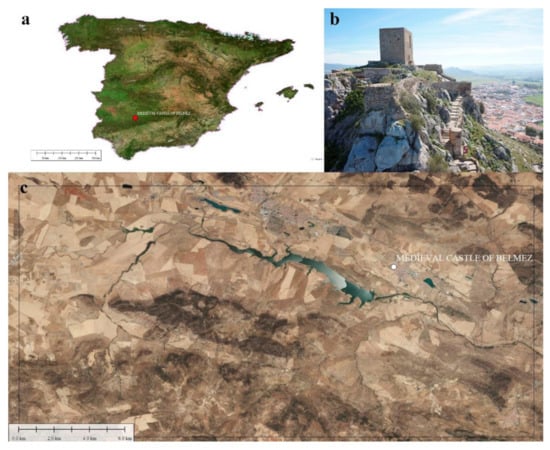
Figure 1.
(a) Location of the medieval Castle of Belmez. (b) Panoramic view from the Cerro del Castillo of Belmez. (c) Area surrounding the castle shown using Virtual Reality imaging. Copyright “Ager Mellariensis”/AEI FEDER HAR 77136-R.
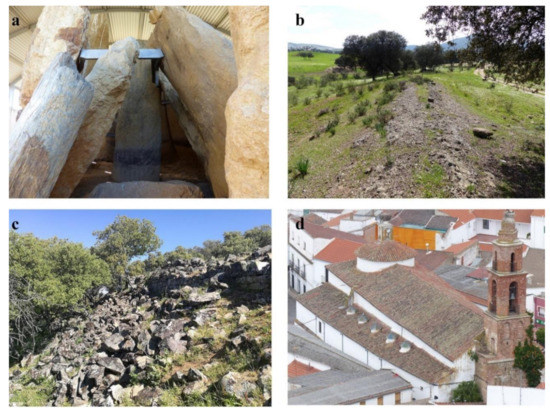
Figure 2.
Monuments located in the area surrounding the Cerro del Castillo of Belmez (CCB). Copyright “Ager Mellariensis”/AEI FEDER HAR 77136-R. (a) Casas de Don Pedro megalithic monument (5500–2500 BC). (b) Roman road in Espiel (1 BC). (c) Andalusí fortress in El Hoyo (10 AD). (d) Medieval church of Belmez (13 AD).
In the nineteenth century, the Société Houillère et Métallurgique de Belmez and later the Societé Minerometalurgique de Peñarroya-Pueblonuevo created the largest lead smelting complex in the world and the second most important coal mining basin in Spain. The French Quarter and the industrial complex of Peñarroya Pueblonuevo are magnificent examples of the heritage that remains from that glorious past [6,7].
Unlike other sites [8], this rich cultural heritage has never been fully researched, rehabilitated, or developed as a narrative landscape until now. To recover this site, it must be interpreted as a multitemporal landscape comprised of several superimposed layers and interwoven texts [9], from which today’s inhabitants can interpret their history and understand their cultural roots [10].
The process of researching, protecting, and promoting this heritage while preserving its diachronic and narrative value has been a challenge for various reasons. The 800 hectares of land are of very difficult to access for the purpose of carrying out ground archeological investigations due to the existence of a reservoir, restrictions on entering private properties, and the lack of previous research projects. However, these difficulties have not obstructed our previous investigations [11,12,13]. A further challenge stems from the fact that the site is located in one of the most economically disadvantaged areas of Spain, with the highest unemployment rate in the European Union. Moreover, the Alto Guadiato has no major roadways or railroads and very few museums or cultural facilities, and the protection of the area’s cultural heritage is still in a nascent stage.
There are many examples of the rehabilitation of cultural landscapes, where the sum of actions and the progressive recovery of monuments create a heritage landscape without a pre-established discourse. In other cases, there is a preparatory story [14,15].
Our objective was to use state-of-the art tools and technologies to digitize heritage resources in 3D format, with a clear research, social, and discursive intention strategy. To this end, photogrammetric flights were conducted and a general inventory was made of the area’s monumental and natural resources, which served as the documentary base for the project. More specifically, the resources were digitized by means of photogrammetric acquisitions using unmanned aerial vehicles (UAVs), airborne thermal and RGB captions, and light detection and ranging (LiDAR) data from the free access IGN files. Subsequently, a monographic study was carried out for the cases that make up this landscape discourse. Regards this second objective, we were particularly interested in the most significant heritage resources located on public land, such as Belmez Castle, which is presented here as an example of the methodology used.
The social function of heritage is an essential aspect of the very notion of a cultural landscape [16], which requires multidisciplinary and cross-cutting collaboration between various scientific and technological agents. For this reason, our research was not framed within a specific method, theme, or discipline. Rather, we have drawn on the diverse disciplines of heritage science (earth observation, remote sensing, nature conservation, archeology, and computation) as an opportunity for the social improvement of the area and the configuration of this landscape narrative, where digitization plays a fundamental role in the enjoyment, promotion, and visualization of heritage [17].
A wide range of comprehensive actions have been employed for the recovery of heritage in rural areas of Spain [18,19]. Because these areas are typically characterized by a low population density and low wealth, their cultural heritage is usually not as well conserved as that of large cities or historical sites, which are generally more successful in securing funding and attracting leading research teams. As a result, the country’s rural heritage has taken longer to be defined conceptually [20]. However, under the Research and Innovation Smart Specialisation Strategy (RIS3) of the European Union and its implementation in the region of Andalusia, heritage development has become a key instrument for rural development and a strategy to curb depopulation in these areas [21].
This paper presents a multidisciplinary research project for the social and cultural recovery of a rural archeological landscape known as the Cerro del Castillo (CCB) located in the town of Belmez, Cordoba (southern Spain); a site that has not undergone any recuperation actions. The general strategy consisted of the digitization of the site’s material and natural heritage resources, after which the research was conducted and the results were disseminated. In the first stage of the project, photogrammetric flights were conducted over the area surrounding the CCB to obtain a geomorphological map covering more than 800 hectares. This information was then used for the volumetric recomposition of the most significant heritage elements and previously identified archeological sites [22]. A more detailed and specific photogrammetric model of the CCB and the fortress was also obtained. Regarding the area’s natural heritage, the flora and fauna were catalogued, with the aim of protecting the species and integrating them in the general heritage discourse. Given that the castle as it stands today is the result of several construction phases, stratigraphic studies were performed to determine the building’s historical construction, damage, and rehabilitation phases. Finally, based on the research findings, a landscape of more than 60 km wide and 40 km deep was virtualized in 3D in order to protect, extend, and develop the full social potential of this archeological and natural heritage.
2. Materials and Methods
To achieve the above aims, a combination of earth observation, remote sensing, archeology, and natural science materials and methods were employed.
2.1. Earth Observation: Open Resources of the Spanish National Geographic Institute
LiDAR data acquisitions and orthophotogrammetric surveys of the Spanish National Geographic Institute (IGN-Spain) were used. LiDAR data for the entire surface of Spain are freely available and constitute an exceptional resource for aerial archeology prospection, as evidenced by their increasingly frequent use. In recent years, several archeological sites have been identified using LiDAR data from the National Aerial Orthophotography Plan of Spain (PNOA), including prehistoric settlements [23] and Roman camps [24], among others. The project researchers also used LiDAR data for the geoarcheological characterization of the site [25] and to identify large Roman construction sites [26].
From 2013 to 2014, IGN-Spain carried out a LiDAR acquisition process for the whole region of Andalusia, which completed the general LiDAR-PNOA acquisitions obtained for all of Spain, beginning in 2010. LiDAR-PNOA point clouds with a density of 0.5 points/m2 and an altimeter accuracy of about ±20 cm of the root mean square error (RMSE) were acquired. The points were classified automatically. The LiDAR data files are presented in Log ASCII Standard (LAS) format or the Log ASCII Zipped (LAZ) format. The data are accompanied by some Supplementary Files, including a decompression tool and visualization of the LAZ and LAS files, metadata, specifications, and a file of acquisition dates. The LAZ file can be downloaded directly from the IGN-Spain website [27].
Updated orthoimages of Spain and Andalusia were also acquired by IGN-Spain. This geographic documentation allows several applications for the aerial detection of archeological sites in the landscape of the Alto Guadiato Valley. The digital orthophotos of PNOA flights have a pixel size of 0.25 m or 0.50 m and can be downloaded from the IGN-Spain website in Tagged Image File Format (TIFF), together with the corresponding georeferencing World File Format (TFW) files. The PNOA orthomosaics were generated by sheets at 1/50,000 and are of maximum resolution and maximum topicality in Enhanced Compression Wavelet (ECW) format. All technical parameters are available on the website [28].
2.2. Remote Sensing: Thermal, RGB, and DTM Acquisitions
The graphic documentation of archeological heritage in Spain [29,30] and Europe [31,32] has advanced rapidly in recent years, owing to the development of consumer UAVs and user-friendly, high-performance photogrammetric software. This technology was used to conduct three photogrammetric acquisition campaigns in the surroundings of the CCB and at the top of the castle (Figure 3).
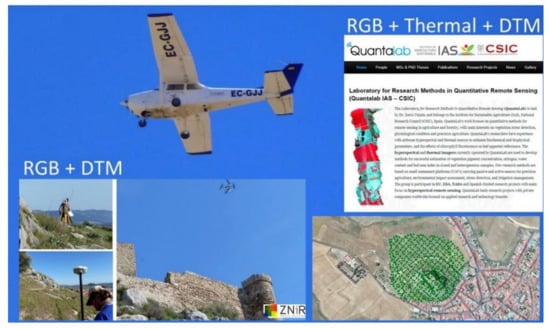
Figure 3.
Ortophotogrammetric acquisition survey of the area surrounding the CCB and the medieval Castle of Belmez, performed by aircraft and drone with RGB and thermal sensors. Images from Quantalab-IAS/CSIC and ZNIR for “Ager Mellariensis”/AEI FEDER HAR 77136-R.
The first airborne survey (30 June 2014 at 12 p.m. UTC + 01:00) covered an area measuring 1040 hectares. The survey was carried out using two sensors mounted simultaneously on board in a Cessna aircraft flying at 250 m above ground level. The first sensor was a FLIR SC655 thermal camera (FLIR Systems, Inc., Wilsonville, OR, USA) with a resolution of 640 × 480 pixels, which was equipped with a 13.1 mm F1.3 lens connected to a computer via USB2.0 protocol. The spectral response was in the range 8–12 µm. The camera was calibrated in the laboratory (Quantalab; IAS-CSIC, Cordoba, Spain) to obtain radiance values. A total of 5133 images were acquired during this survey. Orthorectification and imagery mosaicking were conducted using the structure from motion method (SfM) to obtain two thermal mosaics in Kelvin degrees with a spatial resolution of 0.37 m/px. The second sensor for this first campaign was an RGB sensor (NIKON D800E). A total of 3473 images were acquired. Orthorectification and imagery mosaicking were conducted as described above for thermal mosaic images, allowing us to obtain a very high-resolution orthophoto and a digital surface model (DSM) with a spatial resolution of 0.036 m/px.
For the second campaign, a UAV survey was performed (1 March 2016 at 12 p.m. UTC + 01:00). The UAV-based photogrammetric data acquisition campaign was conducted with a Sony Alpha 5000 20.1 MP RGB sensor mounted onboard a UAV flying at 80 m above ground level. The UAV platform was a multicopter (rotary-wing UAV). Two flights were made due to differences in the terrain elevation. The flight plans were designed in grid mode to ensure the best overlap. A total of 809 images covering an area of 22.49 hectares were acquired. Seven ground control points were measured with GPS to ensure the accuracy and spatial location of the model. Orthorectification and imagery mosaicking were conducted using SfM, allowing us to obtain a very high-resolution orthophoto and a DSM with a spatial resolution of 0.025 m/px.
The goal of the third campaign was to document the castle walls. A UAV-based photogrammetric data acquisition campaign (2 March 2016 at 12 p.m. UTC + 01:00) was conducted with the same Sony Alpha 5000 20.1 MP RGB sensor and the same rotary-wing UAV. The flight was performed in manual mode due to the complexity of the castle structures. A total of 441 images of the castle walls and tower were acquired. Seventy-five ground control points were measured using a total station to ensure the accuracy and spatial location of the model. Orthorectification and imagery mosaicking were conducted using SfM to obtain a very high-resolution orthophoto of all of the structures (<0.001 m/px).
2.3. From Aerial Acquisitions to Archeological Prospection: Identification Workflow
We identified several sites in the area surrounding Belmez based on the available LiDAR-PNOA data, as well as thermal flights, geophysical surveys, and ground recognition surveys. Ground prospection testing is an essential part of the process used to confirm possible new archeological sites discovered from the air.
Regarding the workflow, the first step was to assess the shapes of the newly identified sites. In prehistoric, Roman, and medieval archeology, the shapes of different settlements are well known, which allowed us to assess the veracity of the forms detected in the landscape. The second step entailed photogrammetric documentation or geophysical prospection to assess the formal characteristics of the sites in greater detail. The third step was to determine the chronology of the sites by means of ground recognition, which involved collecting archeological pieces of pottery or other materials. Finally, the fourth step was archeological excavation (Figure 4).
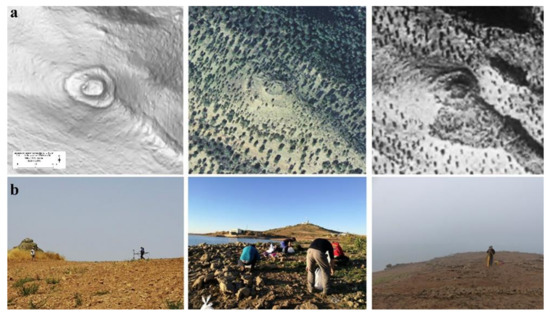
Figure 4.
(a) Workflow for the identification of archeological sites using LiDAR-PNOA data combined with PNOA multitemporal imagery. (b) Geophysical survey, ground prospection, and archeological excavation in the area surrounding Belmez. Copyright “Ager Mellariensis”/AEI FEDER HAR 77136-R.
There is a vast array of literature on aerial acquisition and archeological prospection, with many studies using a methodology similar to ours, which takes into account aerial analysis, photogrammetric acquisitions, geophysical surveys, and surface recognition [33].
2.4. Archeological Stratigraphic Analysis of the Castle
Buildings of historical interest are not the result of a single action, but rather a succession of construction and destruction that takes place throughout the building’s life. In this regard, buildings are the reflection of a sequence of transformations that include a group of construction phases, spaces, and uses that have existed, and in some cases have disappeared (Figure 5).
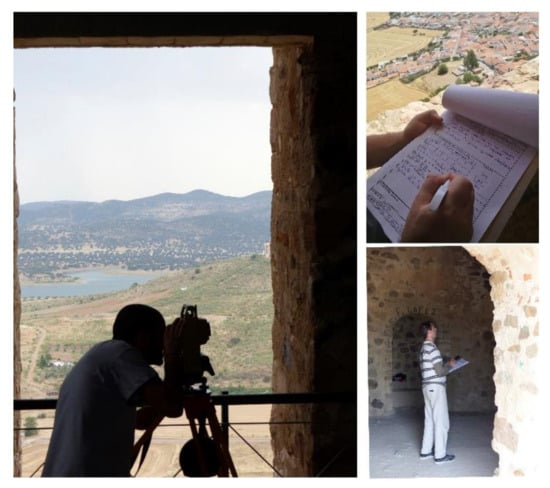
Figure 5.
Geomatics acquisitions and documentation of temporal relationships in Belmez Castle. Copyright “Ager Mellariensis”/AEI FEDER HAR 77136-R.
The archeology of architecture framework approaches a construction site intends to explain the sequence of historical transformations, understanding the societies that built it, and determining the real structure. This methodology enables identification, differentiation, and interpretation of the temporal relationships of the different parts of a building [34].
In addition to the stratigraphic analysis, the typology of the castle’s structural and decorative elements was determined by means of physical–chemical analyses of the building materials and analysis of written and graphic documents from the building. Archeological analysis involves individualizing the building within a single context, consisting of minimal structural entities with a three-dimensional volume or damage events represented by cuts or boundaries and characterized by their physical and technical unity, as well as a common structural purpose.
Using recording sheets and field plans, we described each unit synchronically and diachronically (i.e., the earliest and latest units) with respect to the units they have contact with to determine and reconstruct the temporal sequence of the building. At this point, a synthesis and periodization process was carried out using a matrix diagram to document the construction, reconstruction, relations, and sequencing of the stratigraphic units using the four strategies mentioned above.
2.5. Vegetation, Invertebrates, and Birds
The 23 hectares of the CCB mapped in the final photogrammetric flight were chosen for the protection and enhancement of the native fauna and flora.
For the study of the CCB biodiversity, several actions were carried out to provide an inventory of the main taxonomic groups. Specifically, the hill surface was subdivided into three units: (1) pastureland; (2) rupicolous habitats containing different slopes, shrubs, and small trees; (3) the walled area of the castle, which was the most anthropized area. The three units were sampled in 49 sessions from September 2017 to June 2018.
To monitor and quantitatively study the biodiversity of the CCB and the hill on which the castle is located (7.3 ha), various sampling methods were required. For the invertebrates, which is the most diverse group with the largest number of living forms in the area, 18 transect lines of 600 m were used, primarily to sample insects (mainly Lepidoptera, Odonata, and Coleoptera). To capture other edaphic insects that were not detected in the transects, pitfall traps baited with attractant (beer, wine, or vinegar) diluted in water (10%) were used. Twenty pitfall traps were placed in each habitat unit at a linear distance of 10 m. These traps are an excellent tool for detecting the presence or monitoring the activity of edaphic arthropod communities and performing phenological studies over the short or medium term.
To detect other groups of non-arthropod invertebrates (mollusks) or non-insect arthropods (crustaceans, arachnids, etc.), eight search sessions were carried out in situ, involving looking under rocks, sieving through leaf litter, and searching at the bottom of shrubs or in rock crevices.
For the detection of birds, observation sessions were carried out from strategically located lookout points using a telescope to identify all possible species, as well as from listening stations to identify other species by song or call. Reptiles, amphibians, and mammals located during the invertebrate sampling were also identified. For mammals, bones or skulls located during the sampling or in the pellets of birds of prey were also analyzed, as well as tracks or any other trace of their presence or passage (hair, feces, prey invertebrates or vertebrates, burrows, dens, daybeds, etc.).
For the flora inventory, 12 transects were used (four in October 2017 and eight from April to June 2018) to identify as many of the dominant herbaceous species as possible in the pasturelands and rocky habitats of the study area. Species requiring a microscopic structure study for their identification were collected, labeled, and herborized on sheets.
3. Results
3.1. Geomorphology and the Identification of New Archeological Sites
The general and specific photogrammetric flights made over the CCB landscape allowed us to discover new sites, define the geomorphology of this environment, and characterize already known sites more precisely (Figure 4).
In the landscape near the CCB, thermal sensors revealed the course of the Roman road running from Corduba to Mellaria. From literary sources dating to the Roman period, it is known that the first stretch of this road reached Mellaria, which is only about 8 km from Belmez. However, the exact location was previously unknown and we were able to document a stretch of about 500 m that crosses the entire town of Belmez [35].
Other significant findings (Figure 6), such as a series of previously unknown archeological sites located in the Sierra de los Santos just opposite the CBB in the central part of the landscape, were also identified by remote sensing. Although some sites dating to the Chalcolithic period were known, previously unknown settlements of pre-Roman, Roman, and medieval origin were documented by means of photogrammetric and airborne LiDAR-derived data.
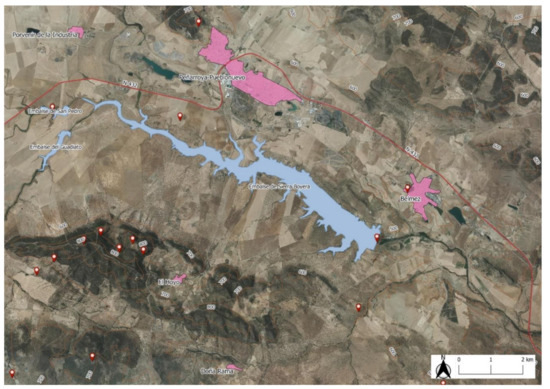
Figure 6.
New archeological sites detected through remote sensing surveys in the area surrounding the CCB. Copyright “Ager Mellariensis”/AEI FEDER HAR 77136-R.
Archeological prospections or excavations (Figure 7) were conducted in some of the sites to determine their exact chrono-cultural adscription. As a result, the entire hilly sector located opposite the CCB was investigated and integrated into the virtual resources presented below. Finally, the photogrammetric and LiDAR flights also permitted the geomorphological characterization of this landscape, where water courses, extinct roads, and alterations due to mining activities in the nineteenth and twentieth centuries were detected (Figure 8 and Figure 9).
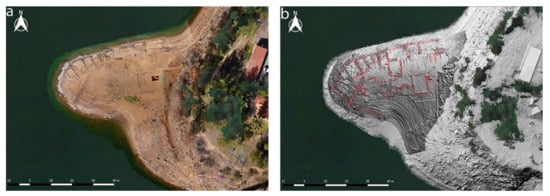
Figure 7.
Archeological site documented through remote sensing acquisitions. (a) Aerial overview. (b) Digital Terrain Model. Copyright “Ager Mellariensis”/AEI FEDER HAR 77136-R.

Figure 8.
Results of the ortophogrammetric acquisitions of the area surrounding the CCB: (a) DTM; (b) RGB sensor; (c) thermal sensor. Taken from Quantalab-IAS/CSIC and ZNIR for “Ager Mellariensis”/AEI FEDER HAR 77136-R.
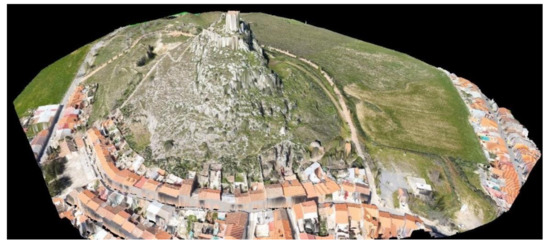
Figure 9.
Results of the ortophotogrammetric acquisitions of the CCB. Images from ZNIR for “Ager Mellariensis”/AEI FEDER HAR 77136-R.
All of these landmarks, which date from 2500 BCE to the twentieth century, allowed us to construct our narrative discourse.
3.2. The Structural Historical Sequence of the Castle of Belmez
According to previous documentation, the tower of Belmez and its surrounding walls are the product of successive reforms in the thirteenth and fifteenth centuries. The most recent reforms were carried out in the nineteenth century during the French occupation [36,37,38]. To further contribute to the current state of knowledge, we performed a stratigraphic analysis within the framework of the archeology of architecture to identify the historical sequence of the structure’s construction.
The tower is the result of an extensive sequence of construction and demolition phases, the results of which do not correspond to a single unified project (Figure 10). The main sequence of the tower can be divided into eight phases, of which the last four date to the twentieth century. In this period, different interventions were undertaken to consolidate the tower following damage to structure suffered in the early 1950s.
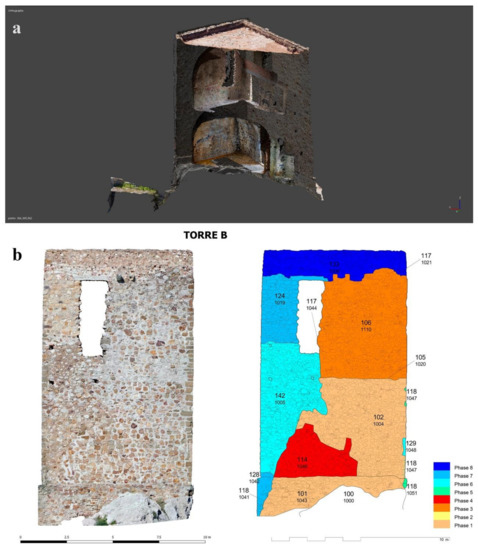
Figure 10.
(a) Results of ortophotogrammetric acquisitions of the tower of the medieval Castle of Belmez. (b) Stratigraphic results. Images from Urbe pro Orbe for “Ager Mellariensis”/AEI FEDER HAR 77136-R.
The lower body of the tower corresponds to the original project (phase 1), which, after adaption of the rock, now stands on a stepped plinth. Its structural characteristics present features typical of Castilian architecture in the region, so we do not believe that it is dated prior to the thirteenth century.
The structural differences observed between the lower and upper bodies of the tower allowed us to identify the effect of early damage (phase 2) that destroyed the roof of the main room and the original upper parts. The characteristics of the upper body contain new material features that allow us to propose that the tower was rebuilt in the late Middle Ages (phase 3).
In modern times (phase 4), during the War of Independence (1810–1812), French troops were stationed in the castle and adapted it to their needs, especially the surrounding wall. At the end of the French occupation, the tower ceased to be inhabited and at the end of the nineteenth century the surroundings were subject to mining activity and a period of abandonment (phase 5), which led to new damage to the tower.
In the early 1960s, the first work to consolidate the tower was carried out by the architect Félix Hernández (phase 6) using traditional techniques. At the beginning of the twenty-first century (phase 7), the reconstruction work on the upper body of the tower was carried out by the architect Antonio Castro Escobar, whose project included closing the southern facade with masonry on an internal structure of concrete beams. The protection given to the edge of the tower terrace corresponds to a very recent renovation phase (phase 8).
3.3. Catalogue of Flora and Fauna
The natural heritage surrounding the castle of Belmez stands out for its rich biodiversity. The area’s flat landscapes, valleys, and limestone and quartzite mountains are home to a huge variety of habitats, which form the foundation of its enormous biological diversity.
A total of 357 species were catalogued during the sampling. The flora, of which 133 species were identified, is well represented in the study area. The structure and the successional state of the plant communities comprised of these primary producers facilitate the presence of phytophagous species that depend on these plants. Regarding the vertebrate fauna, birds are the group with the largest number of recorded species (67). The CCB stands on a limestone outcrop containing a very interesting community of rupiculous birds, two pairs of Eurasian kestrels (Falco tinnunculus), one pair of blue rock thrushes (Monticola solitarius), and a large colony of Alpine swifts (Tachymarptis melba), the latter of which is one of the largest breeding populations in the province of Cordoba.
In addition, eight species of reptiles, three species of amphibians, and four species of mammals were documented, particularly the Egyptian mongoose (Herpestes ichneumon), red fox (Vulpes vulpes), and European hedgehog (Erinaceus europaeus).
Among the invertebrates, the class Insecta is the most diverse and widely represented group in the study area with 122 species. Coleoptera, Lepidoptera, and Hymenoptera are the most abundant orders of insects with 52, 27, and 18 species, respectively. The lack of water sources is a limiting factor for the presence of many aquatic species that have not been detected in the castle’s surroundings but are present in the nearby rivers, ponds, and springs.
Among the insects, the presence of the endemic Iberian mantid Apteromantis aptera is notable. This insect is included in Appendix II of the Bern Convention and Annexes II and IV of the Habitats Directive, and has been considered a strictly protected species under Spanish legislation since 1988. This new finding increases the few sites (currently ten) where this species is present in the province [39,40,41].
4. Discussion: A New Experience in Immersive Virtual Reality for an Enriched Landscape
Our investigations have identified a large number of very important archeological sites surrounding the Castle of Belmez. The new megalithic monuments we have identified confirm the intense construction activities coinciding with the beginning of intensive agriculture in the area. Prior to our research, the megaliths were perhaps the most well-known monuments.
One of the most important advances in terms of our knowledge of this landscape has been the discovery of a Tartessian site in Sierra Boyera [11], which was dated to 7 BC. This is a metallurgical settlement that links the Copper Age with the Iron Age in this area. Just opposite this settlement, also in the Sierra Boyera Reservoir and throughout Sierra de los Santos, we have discovered other previously unknown settlements located next to lead and silver mining veins. These deposits (Figure 4) demonstrate the intensification of industrial activity in Roman times. Another important finding was the discovery of the Corduba–Emerita road [35], which originally ran in front of the castle of Belmez. The Roman road crossed the entire territory and served as a strategic and logistical nexus for the exchange of goods between the cities of Cordoba and Merida. The prehistoric and Roman sections of this road are some of the most well preserved.
The other important development stage in this landscape corresponds to the medieval period, however for different reasons. During this period of abandonment and conflict, the industrial activity disappeared, land ceased to be cultivated at the same intensity, and defensive fortresses were built. Small towns, such as Belmez and Fuente Obejuna (which remain today), were founded and can still be seen from Belmez castle. This is the landscape that we wanted to narrate.
The large amount of data available for the CCB enabled us to develop the usual research, conservation, and dissemination tools. However, given that the information had an enormous visual and narrative potential, we decided to use immersive virtual reality technologies (Figure 11, Figure 12, Figure 13 and Figure 14).
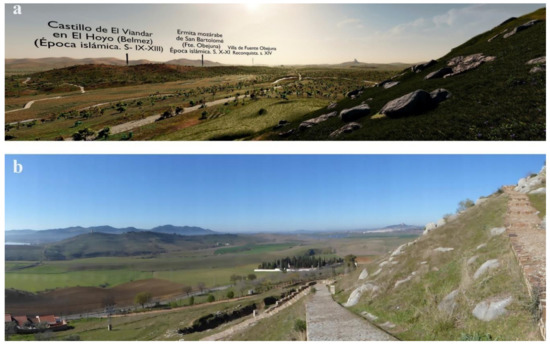
Figure 11.
Area surrounding the CCB shown using VR. View to NW: (a) medieval landscape; (b) current view. Images from Lithodomos VR for “Ager Mellariensis”/AEI FEDER HAR 77136-R.
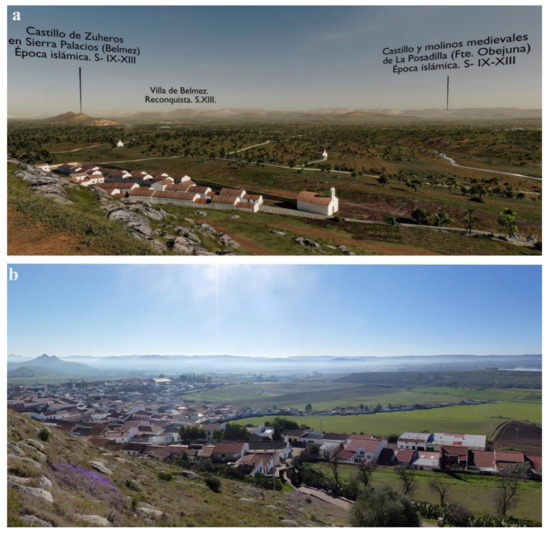
Figure 12.
Area surrounding the CCB shown using VR. View to SW: (a) medieval landscape; (b) current view. Images from Lithodomos VR for “Ager Mellariensis”/AEI FEDER HAR 77136-R.
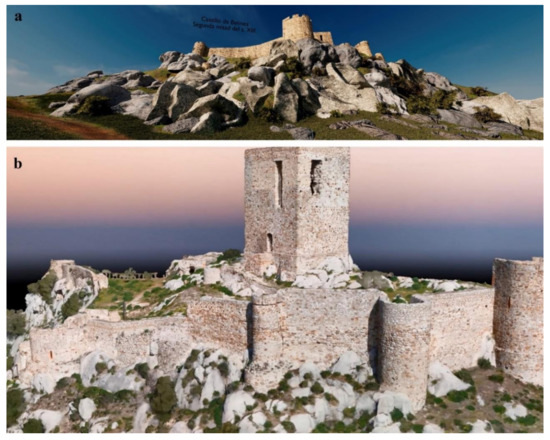
Figure 13.
(a) Medieval Castle of Belmez shown using VR. (b) Photogrammetric acquisition acquired by drone. Images from Lithodomos VR and ZNIR for “Ager Mellariensis”/AEI FEDER HAR 77136-R.
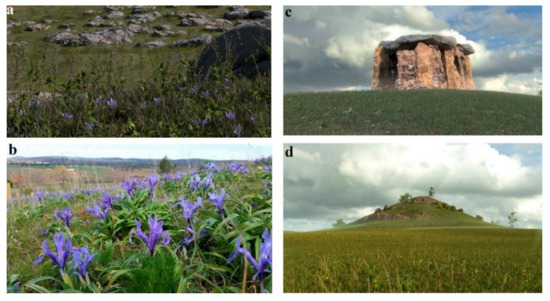
Figure 14.
Area surrounding the CCB: (a) Juno planifolia shown in VR; (b) Juno planifolia in autumn-winter in the CCB; (c) megalithic monument (Figure 2a) shown in VR; (d) acropolis of the Roman city of Mellaria shown in VR. Images from Lithodomos VR for “Ager Mellariensis”/AEI FEDER HAR 77136-R.
There are many examples of the immersive virtualization of monuments, sites, and landscapes. Following the development of photogrammetry and 3D spatial capture techniques, immersive technology has become an increasingly common tool for experiencing heritage visually [42].
Virtualization techniques have been used to investigate archeological sites, although usually only as partial views rather than complete landscapes [43].
Likewise, 3D vision technologies have been used for the research and management of archeological landscapes [44], and there are numerous examples of 3D reconstructions of monuments [45], as well as experiences of inserting certain monuments into existing landscapes [46].
However, experiences in the direct and full-scale recreation of historical landscapes are less common. To extend the findings of this project, we decided to create a virtual lookout of the historical landscape of the Alto Guadiato. This virtual lookout, which is called GudiatVR (www.uco.es/guadiatvr), is not just another virtual recreation. We virtualized an entire landscape, including the air, sunset, incidence of light on the monuments, and other aspects, involving great technical difficulty.
In 2017, Lithodomos VR was commissioned by the University of Cordoba to recreate an in situ lookout for the Ager Mellariensis project using virtual reality. During the project, a number of research, 3D modeling, and application development methodologies were employed. The project was carried out over three broad phases: a definition phase, development phase, and delivery phase.
During the definition phase, researchers at Lithodomos assessed archeological reports, plans, publications, and 3D scans of the area provided by Dr. Monterroso-Checa. These were summarized into a project scope document, which contained digitized references and provided the necessary references for the 3D development team to create preliminary 3D models of the area. The primary software used to create these scenes was the open source application Blender. In addition, the scope document provided the foundation reference for the entire project, as well as all the elements used to build the 3D model. The scope document also recorded all “paradata” [47]. This was to ensure that the process carefully documented how the data collected in previous phases of the project was used in the VR model, as well as all the choices that were made in creating the model. This document evolved over the next phase.
During the development phase, the team visited the site at Belmez. During this brief survey, GPS points were taken at the lookout and the surrounding area. The team visited the landmarks that would appear as “pop-up” windows during the experience. The team also took careful note of the surrounding landscape and its flora and fauna. By combing GPS data collected in situ, LiDAR scans of the area, and real-world scaling in Blender, a geolocated 3D model was created in distinct temporal phases and populated with digital assets created from reference drawings, photographs, and on-site observations. Draft 360° panoramic stereoscopic renderings of the phases of the site were then provided to Dr. Monterroso for review, and correction was carried out where necessary. The 2D “pop-up” images were also created as clickable landmarks from the lookout. Once the digital content had been signed off by Dr. Monterroso, the content was built into a Unity application and published in app stores [48]. Additionally, this background was developed after thought as a web site [49].
During the final delivery phase, some members of the team visited the site again to calibrate the application and to attend the soft launch of the project. Minor adjustments and corrections were made.
As a result of these methodologies, the digitization of traditional archeological reports, such as site plans, elevations, photographs, and field observations, was achieved. This resulted in a high-resolution 3D model of the area over three distinct phases, and in turn 360° panoramic, stereoscopic moving scenes. This data model represents the synthesis and presentation of previous archeological research in a way that a non-specialist visitor to the site can easily understand and enjoy.
5. Conclusions
To briefly conclude, this project has allowed us to recover and reconstruct a historical landscape in a novel and successful way through a combination of heritage sciences. At the local, regional, and national levels, we have developed a unique state-of-the-art tool for the protection, conservation, and promotion of heritage. The tool has been presented at prestigious research and transfer fairs in Spain, and also at one of the largest international tourism events in the world, the Fitur fair in Madrid. The GudiatVR app can be downloaded from IOS and Google Play (Figure 15). People can enjoy an immersive experience in the very center of the CCB, where a “mirador virtual” or virtual lookout point was placed. More importantly, this virtual lookout brings the past to life, is accessible to all, is both scientific and attractive, and has served to heighten public interest in these archeological sites. We are currently working on these sites monographically, involving a strong social component.
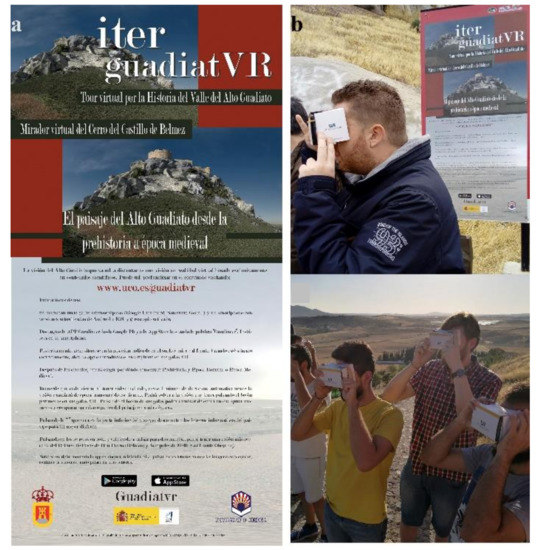
Figure 15.
Lookout VR tools installed in the CCB. (a) Instructions for IOS and Google Play apps; (b) Using of GudiatVR app; Copyright “Ager Mellariensis”/AEI FEDER HAR 77136-R.
Prior to this project, the local population of this area of northern Cordoba only looked back to its recent nineteenth century industrial mining past—its most immediate heritage. However, we now know that the origins of this area date to the Chalcolithic period and that it contains numerous Roman archeological remains, such as the road that once passed by the medieval castle that still stands in the town, and that the stone used for the castle had also been used in antiquity, long before medieval times.
Additional results from this protocol are currently being developed. All the documentation acquired led to a clear conclusion—we must find new ways to protect and preserve the medieval castle of Belmez.
Therefore, all the photogrammetric acquisitions of the castle were modeled in SketchUp in the first step. In the second step, all the data and 3d acquisitions were managed in TrimbleConnect Building Investigation Modelling (BIM) software (Figure 16).
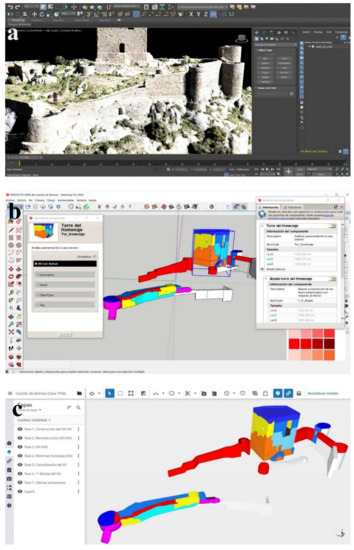
Figure 16.
(a) Example of a photogrammetric acquisition. (b) SketchUp software modeling. (c) TrimbleConnect BIM platform. Copyright “Ager Mellariensis”/AEI FEDER HAR 77136-R.
These steps endowed the castle’s three-dimensional scientific documentation with a horizon of interoperability that did not previously exist, whereby volume calculations or specific measurements can be made automatically. Elements such as towers and stretches of wall were parameterized with the ”components” option, dividing the architectural spaces in order to provide an organized and specialized work experience for each conserved element. For future restoration interventions, the medieval castle of Belmez is at the BIM maturity level in accordance with the awarding of grants from the Spanish Ministry of Development.
We have told the story and preserved the castle and its surrounding environment through virtual and digital data files. Now, we “only” need to obtain the funding for the architectural restoration.
Supplementary Materials
The following are available online at www.uco.es/guadiatvr, GuadiatVR App in IOS and Google Play.
Author Contributions
Conceptualization, A.M.-C., A.R.-V.; methodology, M.G., A.H., B.I., R.M.-T., J.C.M.-E., J.I.M.-F., R.O.-R., N.V., S.J.Y., R.Y., P.Z.-T.; software, M.G., A.H., B.I., N.V., R.Y.; validation, A.M.-C., M.G., P.Z.-T.; formal analysis, R.M.-T., J.M.-C., J.I.M.G.; investigation, A.M.-C., A.R.-V., M.G., A.H., B.I., R.M.-T., J.M.-C., J.C.M.-E., J.I.M.-F., R.O.-R., N.V., S.J.Y., R.Y., P.Z.-T.; resources, A.M.-C., A.R.-V.; data curation, A.M.-C., A.R.-V., M.G., A.H., B.I., R.M.-T., J.M.-C., J.C.M.-E., J.I.M.-F., R.O.-R., N.V., S.J.Y., R.Y., P.Z.-T.; writing—original draft preparation, A.M.-C., A.R.-V., M.G., A.H., B.I., R.M.-T., J.M.-C., J.I.M.-F., R.O.-R., N.V., S.J.Y., R.Y., P.Z.-T.; writing—review and editing, A.M.-C.; visualization, A.M.-C.; supervision, A.M.-C.; project administration, A.M.-C.; funding acquisition, A.M.-C., A.R.-V. All authors have read and agreed to the published version of the manuscript.
Funding
This research was funded by Agencia Estatal De Investigación (National Research Agency—Spanish Ministry of Science and Innovation) with European Regional Development Fund actions (FEDER). Grant number AEI FEDER HAR 2016 77136-R. The Author Processing Charges was funded by Antonio Monterroso Checa using discount MDPI reviews vouchers.
Acknowledgments
The authors would like to thank the municipal government of the town of Belmez and Martha Gaustad for the translation and correction of the article.
Conflicts of Interest
The authors declare no conflict of interest.
References
- Vera Rodríguez, J.C. Formación y desarrollo de las primeras sociedades metalúrgicas en la comarca minera del alto valle del Guadiato (Córdoba). In II Simposio de Prehistoria Cueva de Nerja: Las Primeras Sociedades Metalúrgicas en Andalucía; Palau, A.A., Ed.; Fundación Cueva de Nerja: Nerja, Spain, 2000; pp. 321–329. [Google Scholar]
- Blázquez, J.M.; Domergue, C.; Sillieres, P. La Loba (Fuenteobejuna, Province de Cordoue, Espagne); La Mine et le Village Minier Antiques: Bourdeaux, France, 2002. [Google Scholar]
- Rodríguez Neila, J.F. Corduba, el mons Marianus y el conventus Cordubensis. Conimbriga 2019, 58, 193–232. [Google Scholar] [CrossRef]
- Córdoba de la Llave, R. La fortificación de hábitats en altura almohades: La comarca del Alto Guadiato (Provincia de Córdoba) en los siglos XII–XIII. In Proceedings of the Actas del IV Curso de cultura medieval. Seminario: La fortificación medieval en la Península Ibérica, Centro de Estudios del Románico, Aguilar de Campoo, Palencia, Spain, 21–26 September 1992; pp. 189–201. [Google Scholar]
- Guichard, P.; Buresi, P. L’espace entre Sierra Morena et Manche à l’époque almohade. In Actas del Congreso Internacional Conmemorativo del VIII Centenario de la Batalla de Alarcos; Alarcos: Cuenca, Spain, 1996; pp. 125–143. [Google Scholar]
- Hernando-Luna, R.; Hernando-Fernández, J.L. La Cuenca Carbonífera de Peñarroya- Belmez-Espiel (Córdoba). Reseña Geológico-Minera y Corpus Bibliográfico Boletín de la Real Academia de Córdoba; Real Academia de Córdoba, de Ciencias, Bellas Letras y Nobles Artes: Córdoba, Spain, 2003; Volume 145, pp. 223–251. [Google Scholar]
- Ruiz Martín, A.M. Las explotaciones mineras del Alto Guadiato: La imagen de la minería en la comarca. In Boletín Geológico y Minero; Dialnet: Córdoba, Spain, 2010; Volume 121–122, pp. 189–202. [Google Scholar]
- Drenthen, M. Layered Landscapes, Conflicting Narratives, and Environmental Art. In Restoring Layered Landscapes: History, Ecology, and Culture; Hourdequin, M., Havlick, D.G., Eds.; Oxford Press: Oxford, UK, 2015; pp. 239–262. [Google Scholar] [CrossRef]
- Drenthen, M. Reading ourselves through the land: Landscape hermeneutics and ethics of place. In Placing Nature on the Borders of Religion, Philosophy, and Ethics; Clingerman, F., Dixon, M., Eds.; Ashgate: Farnham, UK, 2011; pp. 123–138. [Google Scholar]
- Monterroso Checa, A.; Vicente, F. Project Ager Mellariensis: Archaeology to Improve the Competitiveness of the Urban and Rural Areas of the Area of Alto Guadiato (Córdoba-Spain); Uniscape En-route 4- Special Series of I Quaderni di Careggi; UNISCAPE: Zoetermeer, The Netherlands, 2016; Volume 4, pp. 272–278. [Google Scholar]
- Gasparini, M.; Moreno-Escribano, J.C.; Monterroso Checa, A. Photogrammetric Acquisitions in Diverse Archaeological Contexts Using Drones: Background of the Ager Mellariensis Project (North of Córdoba-Spain). Drones 2020, 4, 47. [Google Scholar] [CrossRef]
- Gasparini, M.; Moreno-Escribano, J.C.; Monterroso Checa, A. Identifying the Roman road from Corduba to Emerita in the Puente Nuevo reservoir (Espiel-Córdoba/Spain). J. Archaeol. Sci. Rep. 2019, 24.4, 363–372. [Google Scholar] [CrossRef]
- Monterroso Checa, A.; Martínez-Reche, T. COSMO SkyMed X-Band SAR application—Combined with thermal and RGB images—In the archaeological landscape of Roman Mellaria (Fuente Obejuna-Córdoba, Spain). Archaeol. Prospect. 2018, 25.4, 301–314. [Google Scholar] [CrossRef]
- Tolia-Kelly, D.P. Narrating the postcolonial landscape: Archaeologies of race at Hadrian’s Wall. Trans. Inst. Br. Geogr. 2011, 36.1, 71–88. [Google Scholar] [CrossRef]
- Coomans, T.; Cattoor, B.; De Jonge, K. Mapping Landscapes in Transformation. Multidisciplinary Methods for Historical Analysis; Leuven University Press: Leuven, Belgium, 2019. [Google Scholar] [CrossRef]
- Santacana, M.; Awad, R.; Barazzetti, J. Harnessing digital workflows for the understanding, promotion and participation in the conservation of heritage sites by meeting both ethical and technical challenges. Built Herit. 2020, 4–6. [Google Scholar] [CrossRef]
- Jones, M. The concept of cultural landscape: Discourse and narratives. In Landscape Interfaces: Cultural Heritage in Changing Landscapes; Palang, H., Fry, G., Eds.; Springer: Dordrecht, The Netherlands, 2003; pp. 21–52. [Google Scholar] [CrossRef]
- Martín Jiménez, M.I. Heritage and Landscape in Spain and Portugal. From unique value to territorial integration. In Boletín de la Asociación de Geógrafos Españoles; Dialnet: Córdoba, Spain, 2016; Volume 71, pp. 531–535. [Google Scholar]
- Těšitel, J.; Kolbmüller, B.; Stöglehner, G. Vital Landscapes. Valorisation and Sustainable Development of Cultural Landscapes Using Innovative Participation and Visualisation Techniques, Budějovice. 2014. Available online: https://keep.eu/projects/5554/ (accessed on 3 November 2020).
- Sunyer, C.; Mateinga, L. Cultural Landscapes: The Conservation Challenge in a Changing Europe; Bennett, G., Ed.; Institute for European Environmental Policy: London, UK, 1996; pp. 105–124. [Google Scholar]
- Available online: https://www.juntadeandalucia.es/export/drupaljda/Documento-Ris3-version-final-8-27-02-15.pdf (accessed on 3 November 2020).
- Monterroso-Checa, A.; Zarco-Tejada, P.; Hornero, A.; Yuste, R.; Vargas, N. Teledetezione termica aerea e “Smart Archaeology” per la città romana di Mellaria. AltoGuadiato-Córdoba-España. Riv. Archeol. Aerea 2018, 12, 118–127. [Google Scholar]
- Cerrillo-Cuenca, E. An approach to the automatic surveying of prehistoric barrows through LiDAR. Quat. Int. 2015, 12, 135–145. [Google Scholar] [CrossRef]
- Costa-García, J.M.; Fonte, J.; Gago, M. The reassement of the military presence in Galicia and northern Portugal through digital tools: Diversity and historical problems. Mediterr. Archaeol. Archaeom. 2019, 19, 17–49. [Google Scholar] [CrossRef]
- Monterroso-Checa, A. Geoarchaeological Characterisation of Sites of Iberian and Roman Cordoba Using LiDAR Data Acquisitions. Geosciences 2019, 9, 205. [Google Scholar] [CrossRef]
- Monterroso-Checa, A.; Teixidó, T.; Gasparini, M.; Peña, J.A.; Rodero, S.; Moreno, J.C.; Morena, J.A. Use of Remote Sensing, Geophysical Techniques and Archaeological Excavations to Define the Roman Amphitheater of Torreparedones (Córdoba, Spain). Remote Sens. 2019, 11, 2937. [Google Scholar] [CrossRef]
- Available online: http://centrodedescargas.cnig.es/ (accessed on 3 November 2020).
- Available online: https://pnoa.ign.es/productos (accessed on 3 November 2020).
- Fernández-Hernandez, J.; González-Aguilera, D.; Rodríguez-Gonzálvez, P.; Mancera-Taboada, J. Image-Based Modelling from Unmanned Aerial Vehicle (UAV) Photogrammetry: An Effective, Low-Cost Tool for Archaeological Applications. Archaeometry 2015, 57, 128–145. [Google Scholar] [CrossRef]
- Ruiz Sabina, J.Á.; Gallego Valle, D.; Peña Ruiz, C.; Molero García, J.M.; Gómez Laguna, A. Aerial Photogrammetry by drone in archaeological sites with large structures. Methodological approach and practical application in the medieval castles of Campo de Montiel. Virtual Archaeol. Rev. 2015, 6, 5–19. [Google Scholar] [CrossRef]
- Verhoeven, G.; Docter, R. The amphitheatre of Carnuntum: Towards a complete 3D model using airborne Structure from Motion and dense image matching. In Proceedings of the 10th International Conference on Archaeological Prospection, Vienna, Austria, 29 May–2 June 2013; Austrian Academy of Sciences: Vienna, Austria, 2013; pp. 438–440. [Google Scholar]
- Fiorillo, F.; Jiménez Fernández-Palacios, B.; Remondino, F.; Barba, S. 3D Surveying and modelling of the Archaeological Area of Paestum, Italy. Virtual Archaeol. Rev. 2015, 4.8, 55–60. [Google Scholar] [CrossRef]
- Mayoral Herrera, V.; Charro Lobato, C.; Salgado Carmona, J.A.; Pro Muñoz, C.; De Tena, M.T.; Chapa Brunet, M.T.; Vallés Iriso, J.; Terrón, J.M.; Quirós Rosado, E. Radiography of an Iron Age hillfort: Non-invasive archaeology in the settlement of Villasviejas del Tamuja (Botija, Cáceres). Trab. Prehist. 2019, 76, 303–322. [Google Scholar] [CrossRef]
- Caballero Zoreda, L. Experiencia metodológica en Arqueología de la Arquitectura de un grupo de investigación. Instituto de Historia. In Arqueología Aplicada al Estudio e Intervención de Edificios Históricos. Últimas Tendencias Metodológicas; Martín Morales, C., Vega, E., Eds.; CSIC: Madrid, Spain, 2010; pp. 103–120. [Google Scholar]
- Monterroso-Checa, A.; Gasparini, M. Aerial Archaeology and Photogrammetric surveys along the roman way from Corduba to Emerita. Digitalizing the ager Cordubensis and the ager Mellariensis. SCIRES-IT 2016, 2, 175–188. [Google Scholar] [CrossRef]
- Ortiz Juárez, D.; Carpio, C.E. Catálogo Artístico y Monumental de la Provincia de Córdoba, 2nd ed.; Diputación Provincial de Córdoba: Córdoba, Spain, 1983; p. 298. [Google Scholar]
- Valverde Candil, M.; Toledo Ortiz, F. Los Castillos de Córdoba; Córdoba, Spain. 1985. Available online: http://datos.bne.es/edicion/bimo0000208772.html (accessed on 3 November 2020).
- Peñalta Castro, J. Crónicas, Hechos Históricos y Costumbres; Academia de Geografía e Historia de Guatemala: Belmez, Spain, 2009. [Google Scholar]
- Obregón, R.; López, J. Nuevas citas del endemismo ibérico Apteromantis áptera (Fuente, 1894) en la provincia de Córdoba (Andalucía, España) (Dictyoptera: Mantodea). Zool. Baetica 2009, 20, 105–108. [Google Scholar]
- Pascual, F. Apteromantis aptera (Fuente, 1884). In Atlas y Libro Rojo de Los Invertebrados Amenazados de España (Especies Vulnerables); Verdú, J.R., Numa, C., Galante, E., Eds.; ESPANA PUEDE: Madrid, Spain, 2011; pp. 353–359. [Google Scholar]
- Catálogo Español de Especies Exóticas Invasoras. Ministerio de Agricultura, Alimentación y Medio Ambiente. Available online: http://www.magrama.gob.es/ (accessed on 3 November 2020).
- Remondino, F. Heritage Recording and 3D Modeling with Photogrammetry and 3D Scanning. Remote Sens. 2011, 3, 1104–1138. [Google Scholar] [CrossRef]
- Ch’ng, E.; Stone, R.J.; Arvanitis, T.N. A Virtual Reality Archaeological Framework for the Investigation and Interpretation of Ancient Landscapes. In Proceedings of the IASTED International Conference on Internet and Multimedia Systems and Applications, EuroIMSA, Grindelwald, Switzerland, 21–23 February 2005; pp. 527–532. [Google Scholar]
- Luzio, K. 3D archaeological map: Contribution of the reconstruction of the ancient landscape of the west-central area of Salento (Italy). SCIRES-IT 2017, 7, 8–16. [Google Scholar] [CrossRef]
- Remondino, F.; Alessandro Rizzi, A.; Jimenez, B.; Agugiaro, G.; Baratti, G.; De Amicis, R. The Etruscans in 3D: From space to underground. Geoinformatics 2011, 6, 283–290. [Google Scholar] [CrossRef]
- Richards-Rissetto, H.; Robertsson, J.; Schwerin, J.V.; Remondino, F.; Agugiaro, G.; Girardi, G. Geospatial Virtual Heritage: A Gesture-Based 3D GIS to Engage the Public with Ancient Maya Archaeology. In Archaeology in Digital Era Amsterdam; Earl, G., Sly, T., Chrysanthi, A., Murrieta-Flores, P., Eds.; Amsterdam University Press: Amsterdam, The Netherlands, 2013. [Google Scholar] [CrossRef]
- Richards-Rissetto, H. What can GIS þ 3D mean for landscape archaeology? J. Archaeol. Sci. 2017, 84, 10–21. [Google Scholar] [CrossRef]
- Guadiat VR for Android and IPhonecould be Downloaded in Google Play and IOS Store. Available online: https://docs.unity3d.com/Packages/com.unity.xr.googlevr.ios@2.0/manual/index.html (accessed on 3 November 2020).
- Available online: www.uco.es/guadiatvr (accessed on 3 November 2020).
Publisher’s Note: MDPI stays neutral with regard to jurisdictional claims in published maps and institutional affiliations. |
© 2020 by the authors. Licensee MDPI, Basel, Switzerland. This article is an open access article distributed under the terms and conditions of the Creative Commons Attribution (CC BY) license (http://creativecommons.org/licenses/by/4.0/).